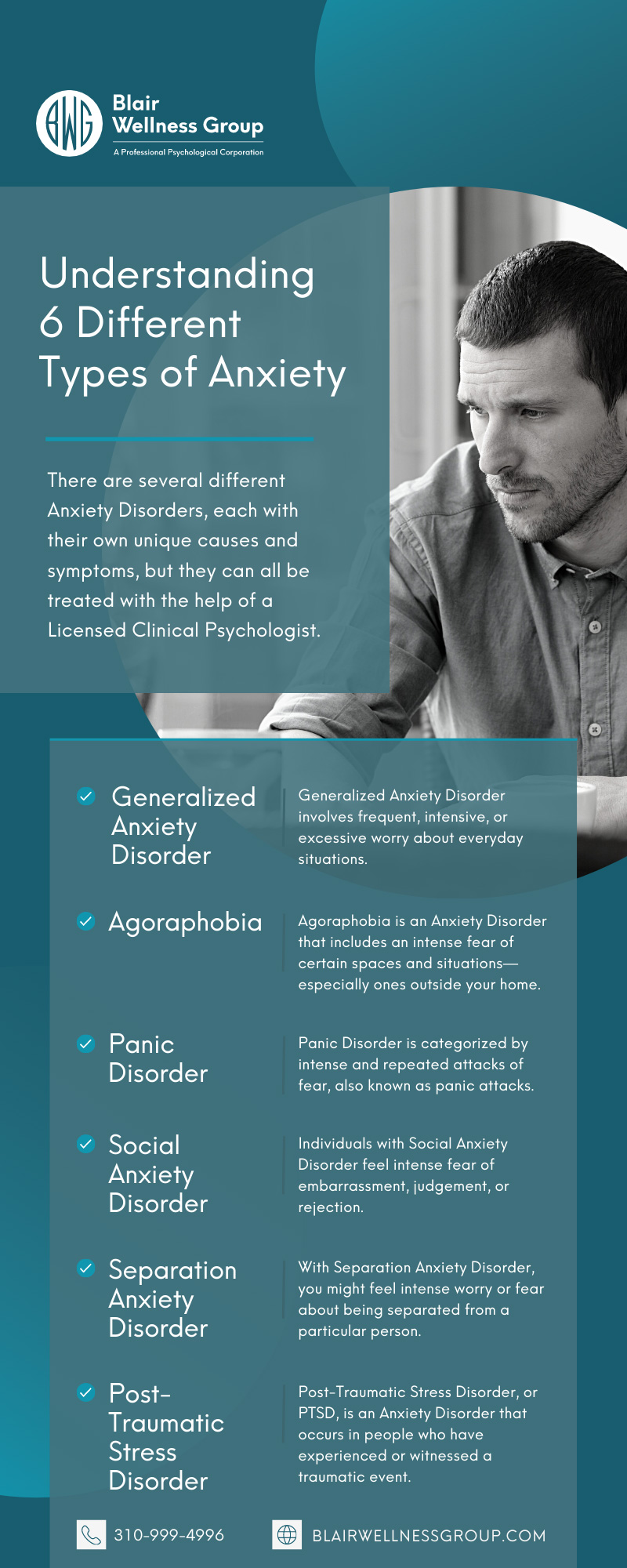Everyone experiences anxiety at some point in their lives. You might feel anxious before an important interview or experience doubt and worry about a major life change. When that anxiety turns into an overwhelming mental turmoil, however, it disrupts your life and causes a wide range of physical, emotional, and psychological issues.
Anxiety Disorders revolve around feelings of worry, fear, dread, and distress that last for a significant period of time. There are several different Anxiety Disorders, each with their own unique causes and symptoms, but they can all be treated with the help of a Licensed Clinical Psychologist. Explore our guide to understanding the different types of anxiety and learn more about how evidence-based treatments can help you with your Anxiety Disorder.
Common Symptoms of Anxiety
There are six main types of Anxiety Disorders, but the different disorders have a lot in common. Each type of Anxiety Disorder can stem from sources such as genetic predisposition, negative childhood experiences, or a traumatic or stressful event.
There are also many symptoms that are common across multiple types of Anxiety Disorders. Persistent feelings of fear, worry, or distress—especially when there is no current obvious threat—are among the most common Anxiety Disorder symptoms. Other signs and symptoms of various Anxiety Disorders include:
- Panic attacks
- Obsessive or compulsive thoughts and actions
- Shortness of breath
- Rapid heart rate
- Hot flashes or unusual sweating
- Headaches
- Feeling faint, lightheaded, or shaky
While these symptoms are common, they aren’t the only signs of Anxiety Disorder. Learning more about the different types of anxiety will help you identify when anxious feelings become a serious Anxiety Disorder, which in turn makes it easier for you to seek the professional treatment you need.
Generalized Anxiety Disorder
Generalized Anxiety Disorder involves frequent, intensive, or excessive worry about everyday situations. You might dread driving to work every day, feel intensively nervous before presentations, or spend hours overthinking about relatively minor events. Individuals with Generalized Anxiety Disorder experience overwhelming feelings of fear and distress in their everyday lives. Even when these feelings are more manageable, you might still experience underlying stress and anxiety for no clear reason.
The consistent worry and distress of Generalized Anxiety Disorder can lead to symptoms like restlessness, irritation, or feeling like you don’t have control over your life. The ongoing stress can also lead to individuals with General Anxiety Disorder feeling drained, fatigued, and lethargic. You might also experience tense, sore muscles—especially around the neck, shoulders, and back. Without treatment, your Generalized Anxiety Disorder will continue to disrupt more of your life, and these symptoms will grow and worsen over time.
Agoraphobia
Agoraphobia is an Anxiety Disorder that includes an intense fear of certain spaces and situations—especially ones outside your home. Individuals with Agoraphobia might fear leaving their house, being in open spaces or close, crowded spaces, standing in crowds, using public transportation, and similar situations.
This overwhelming fear can eventually lead to you avoiding leaving the house or being out in public altogether. You might feel intense stress or tension when performing regular tasks such as going to the grocery store or taking the trash out. Alternatively, your feelings of anxiety might revolve around social situations like hanging out with friends or talking to strangers.
Panic Disorder
Panic Disorder doesn’t revolve around a specific situation or setting. Instead, Panic Disorder is categorized by intense and repeated attacks of fear, also known as panic attacks. People with Panic Disorder have experienced one or more panic attacks in their life and often feel worried or scared about when the next attack might occur.
A panic attack is an intense and upsetting experience. While a panic attack includes mental distress, it’s also categorized by the severe physical symptoms that accompany it: shortness of breath, a rapid heartrate, hot or cold flashes, chest pain, dizziness, and more.
Even when you’re not experiencing a panic attack, you might struggle with overwhelming fears or worries about when the next panic attack is coming. This fear can cause individuals with Panic Disorder to avoid people or situations that they think might bring on a panic attack. As a result, Panic Disorder becomes an ever-present and disruptive obstacle in your life.
Social Anxiety Disorder
Discomfort in social situations is a common symptom of many types of anxiety. However, if that social discomfort begins to affect your daily life or hold you back from various opportunities, you might have Social Anxiety Disorder.
Individuals with Social Anxiety Disorder feel intense fear of embarrassment, judgement, or rejection. They might also worry about appearing anxious in front of others, which in turn causes them to feel more anxious, resulting in a downward spiral.
Separation Anxiety Disorder
With Separation Anxiety Disorder, you might feel intense worry or fear about being separated from a particular person. A common example of Separation Anxiety Disorder is infants or young children feeling immense distress when they’re not around a parent. However, adults can also suffer from Separation Anxiety Disorder.
Separation Anxiety Disorder often stems from losing someone you care about through circumstances such as a divorce, a move, or death. People who had Separation Anxiety Disorder as children are also more likely to experience it as adults.
Post-Traumatic Stress Disorder
Post-Traumatic Stress Disorder, or PTSD, is an Anxiety Disorder that occurs in people who have experienced or witnessed a traumatic event. Common causes of PTSD are serious accidents, assault, military combat, or a natural disaster.
With PTSD, feelings of fear and anxiety revolve around the traumatic event you experienced. In addition to general anxiety symptoms, you might experience nightmares or flashbacks that force you to relive the trauma. The memory of the traumatic event can lead to severe stress, uncontrollable mood changes, and an inability to move forward and enjoy everyday life.
Treatment for Anxiety Disorders
Evidence-based treatment modalities are an effective treatment for Anxiety Disorders. Cognitive Behavioral Treatment (CBT) is a useful strategy when addressing and working through anxiety. With CBT, your Licensed Clinical Psychologist helps you identify the negative thoughts behind your anxiety so that you can redirect your thought processes into something more positive and constructive.
The anxiety treatment services at Blair Wellness Group address and treat Anxiety Disorders through personalized treatment plans that involve CBT and other evidence-based approaches. When you’re ready to seek professional help for your Anxiety Disorder, turn to Dr. Blair and the team at Blair Wellness Group.

Dr. Cassidy Blair is a renowned Licensed Clinical Psychologist and trusted Performance Coach who specializes in providing Concierge-Psychological Care and Executive Coaching for high-achieving professionals. With a deep understanding of the unique challenges faced by CEOs, executives, entrepreneurs, and leaders, Dr. Blair offers tailored, confidential care designed to foster emotional well-being, personal growth, and professional excellence. Her clientele values her discretion, clinical expertise, and emotionally intelligent approach to navigating complex personal and professional dynamics.
- This author does not have any more posts.








